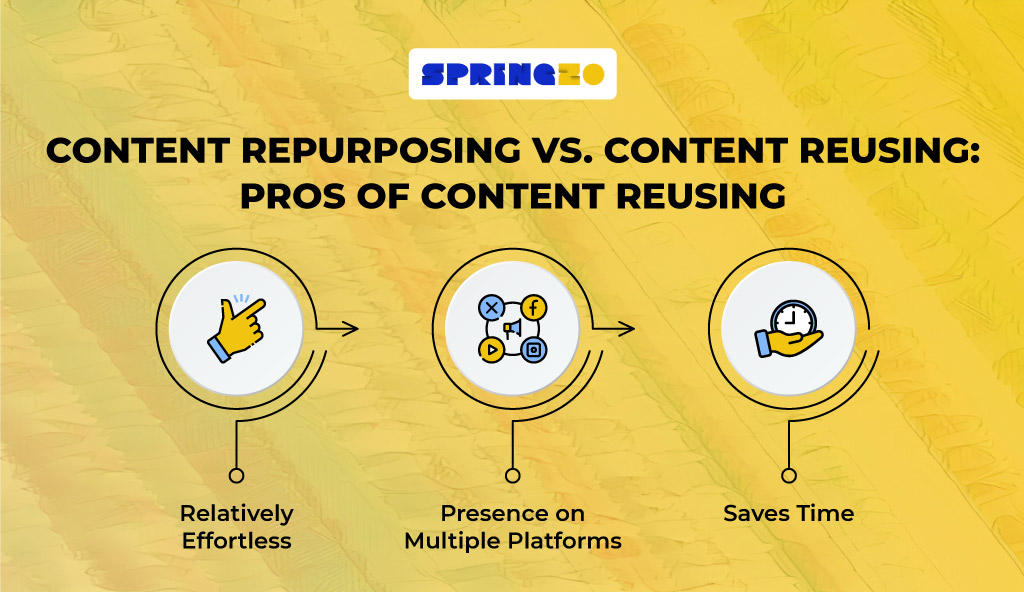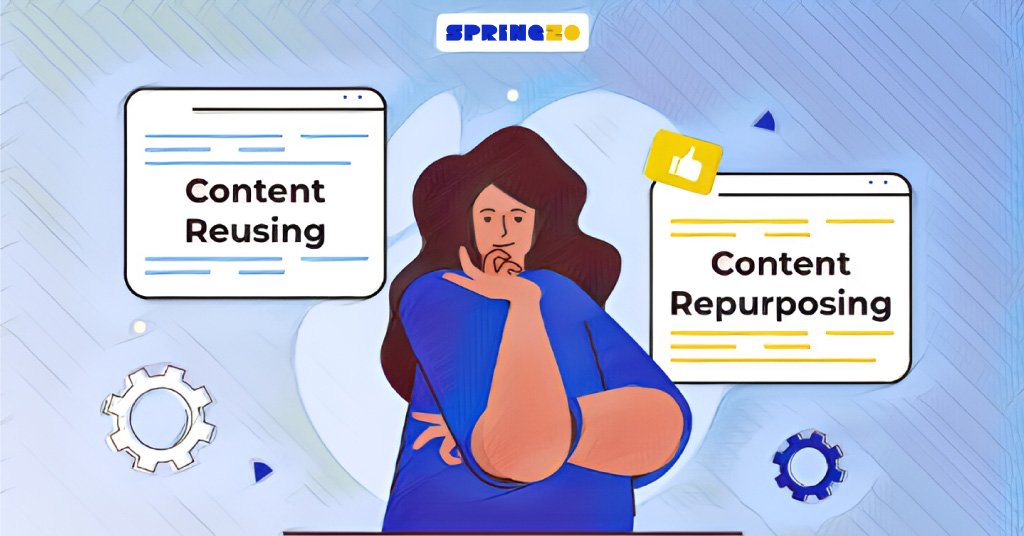All brand stakeholders adore fresh, high-quality, and value-driven content, probably none more than the Search Engines. The statistics speak for themselves:
82% of marketers are investing in content marketing actively. Moreover, 40% of B2B marketers have a documented content marketing strategy for their businesses.
These statistics imply that content demand is rising with time. But how can marketers and brands produce fresh content in less time, lesser effort, and more value?
In this context, many adopt two most widely used strategies: Content Repurposing and Content Reusing. Between the two, repurposing is considered a modern, innovative approach that can infuse new life into existing content oeuvres. It also ensures the core messaging gets broadcasted with more audience retention.
Both content repurposing and reusing may seem identical but they are never the same. Content repurposing is more goal-driven and incorporates multiple considerations. Whereas reusing content focuses on recycling existing material.
In today’s blog post, let us explore the specifics of content repurposing vs. content reusing debate, their advantages, and help you determine which one suits your business needs more.
Content Reusing: An Outline
Content reusing is the act of simply recycling old content without many changes to supply content to a new platform or a new audience.
It is a cheaper alternative to creating fresh content. This strategy is often the best suited for industries, such as education, manufacturing, technical documentation, etc., where repeating the same core material is deemed acceptable.
Content Repurposing vs. Content Reusing: What is the Difference?
While exploring content repurposing vs. content reusing, many often get confused. Despite their apparent similarity, both are quite dissimilar in terms of how they utilize content messaging and how it is broadcast.it is an entirely different thing.
- Content repurposing involves extensively changing the format, duration, or delivery of old content to create any new material.
- In contrast, content reusing entails reposting the same material previously uploaded to a platform.
To illustrate, recycling a particular song would look like republishing it to Apple Music after it has been on another platform, Spotify.
However, the problem here is that the audience stays largely the same. So, there are fewer chances of any further content growth. It is a significant drawback because content reusing lacks freshness and relevance over time. Audiences always crave updated information. So, they may not like relying solely on reused content, often leading to content fatigue.
Also, the audience may perceive the content as redundant, diminishing the chances of any further connection for sustained audience engagement.
Content Repurposing vs. Content Reusing: Pros of Content Reusing

Content reusing has its advantages, such as:
1. Relatively Effortless
The key benefit of content reusing compared to repurposing is that it is quite effortless. This makes content reusing the obvious starting point for getting your material out there.
2. Presence on Multiple Platforms
Individuals who know how to upload content to one platform also know how to upload it to another. This makes content reusing very beginner-friendly.
3. Saves Time
Content reusing is often desired by marketers because it saves time. Yet, it isn’t always the first option for professionals because its effectiveness is limited compared to content repurposing.
Content Repurposing: An Overview
Now, we will focus on the critical component of the content repurposing vs. content reusing debate.
The content repurposing strategy refers to transforming existing content into a new format that aims to reach more people. It helps businesses expand their reach, minimize costs, and establish an online presence.
Content repurposing aims to help content scale faster and appeal to new audiences. So, businesses will be able to engage with the target audience constantly through this technique. Frequent publishing of videos, blog and social media posts, and podcasts will help organizations establish a strong online presence and good relationships with customers.
That is why many industries, like digital marketing and advertising, media, healthcare, real estate, travel, and hospitality, etc., use content repurposing to reach their respective audiences.
Content Repurposing vs. Content Reusing: Benefits of Content Repurposing
Content repurposing is an efficient way to get the most out of your content with plenty of associated benefits.
1. Zero Duplication Penalties
The striking difference between the benefits of content repurposing and reusing is that you can repurpose content on the same platform while reaping its benefits. It is instrumental in avoiding duplication penalties, as the content is often fundamentally altered in terms of form and tone.
In contrast, reusing content on the same platform can get you penalized.
2. Higher Audience Engagement
Content repurposing makes content easy to consume with engagement-driven modifications. Examples include creating short clips, captioning, and boiling down lectures to quote cards. This improves your audience engagement to a large extent.
3. Presence Across Different Platforms
You can repurpose content and use it across different platforms. It applies to platforms, like YouTube, with the same distribution format. The same can be done without any additional expenses.
Content Repurposing vs. Content Reusing: Which is Better?
The choice between content repurposing vs. content reusing comes down to individual preferences and specific requirements.
Content repurposing offers a fresh take on existing material. It also enhances engagement and allows a presence across several platforms. Content reusing is a more straightforward and time-saving approach.
Hence, deciding which of the above techniques is better should be singularly based on your goals, target audience, and the platforms you aim to reach. Many businesses and industries may find more value in the depth of content repurposing because it gives the content more exposure and shelf life.
On the other hand, despite its ease of adoption, reusing content often hampers the audience’s reach and limits growth because it repeatedly uses the same content. It also means the audience will lose interest in the content and divert to other platforms.
The bottom line is that the effectiveness of each approach depends on how well it aligns with your respective content marketing strategy. Consider your resources, time constraints, and the nature of your content. Do it, especially when you decide which path to take to maximize the impact of your content investment.
Springzo: Experts at Content Repurposing
Creating exceptional content is no small feat, and often, its brilliance fades away in the depths of a blog post or podcast episode, never to see the light again. At Springzo, we are here to change that narrative.
We specialize in content repurposing and help breathe new life into your existing content. Imagine your insightful blog post transforming into a captivating infographic, a social media series or a podcast interview evolving into a compelling YouTube video – that’s what we do best.
Ready to see your old content become new viral hits?
Frequently Asked Questions
1. What makes content repurposing different from content reusing?
Content repurposing involves changing aspects of the source material to create new content. Meanwhile, content reusing entails reposting the material as-is on the same or a different platform. Repurposing adds a fresh perspective, while reusing focuses on simplicity and efficiency.
2. Can content repurposing and content reusing be done on the same platform?
Yes, content repurposing allows you to benefit from the same material on the same platform without penalties. Whereas reusing content on the same platform may lead to penalties.
3. How does content repurposing contribute to higher audience engagement?
Content repurposing involves making content easy to consume with engagement-driven modifications such as creating short clips, captioning, and condensing long-form content into quote cards. These modifications enhance audience engagement significantly.
4. Why is content reusing considered relatively effortless?
Content reusing is deemed relatively effortless because it involves reposting content without significant modifications. You can easily do the same on another, making it beginner-friendly and time-saving if you can upload content to one platform.
5. Is there a specific type of content suitable for either repurposing or reusing?
You can apply content repurposing and reusing to various content types. It often includes articles, videos, and graphics. The decision on which method to choose often depends on the nature of the content, the target audience, and the desired level of engagement. Repurposing is ideal for adding depth and variety, while reusing is efficient for maintaining a consistent presence across platforms.
